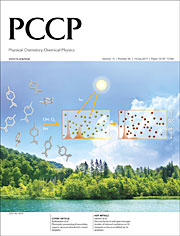- Number 350 |
- November 14, 2011
Atmospheric particles show off their dynamic character

Artwork from this study
graced the cover of Physical
Chemistry Chemical Physics.
When exposed to sunlight, atmospheric aerosols change dramatically, according to scientists at DOE’s Pacific Northwest National Laboratory and the University of California, Irvine. Using resources at EMSL, the team found that the light dices the aerosols’ organic molecules into small acidic bits. The resulting molecules make it easier for clouds to form. Another finding was that the sunlight bleaches the brown particles white, reducing the amount of heat the particles absorb.
Current atmospheric models do not consider the evolving chemistry of the organic aerosols.
[Kristin Manke, 509.372.6011,
kristin.manke@pnnl.gov]
Image reproduced by permission of Professor Sergey Nizkorodov and the PCCP
Owner Societies from Phys. Chem. Chem. Phys., 2011, 13, 3612-3629, DOI:
10.1039/C0CP02032J.
